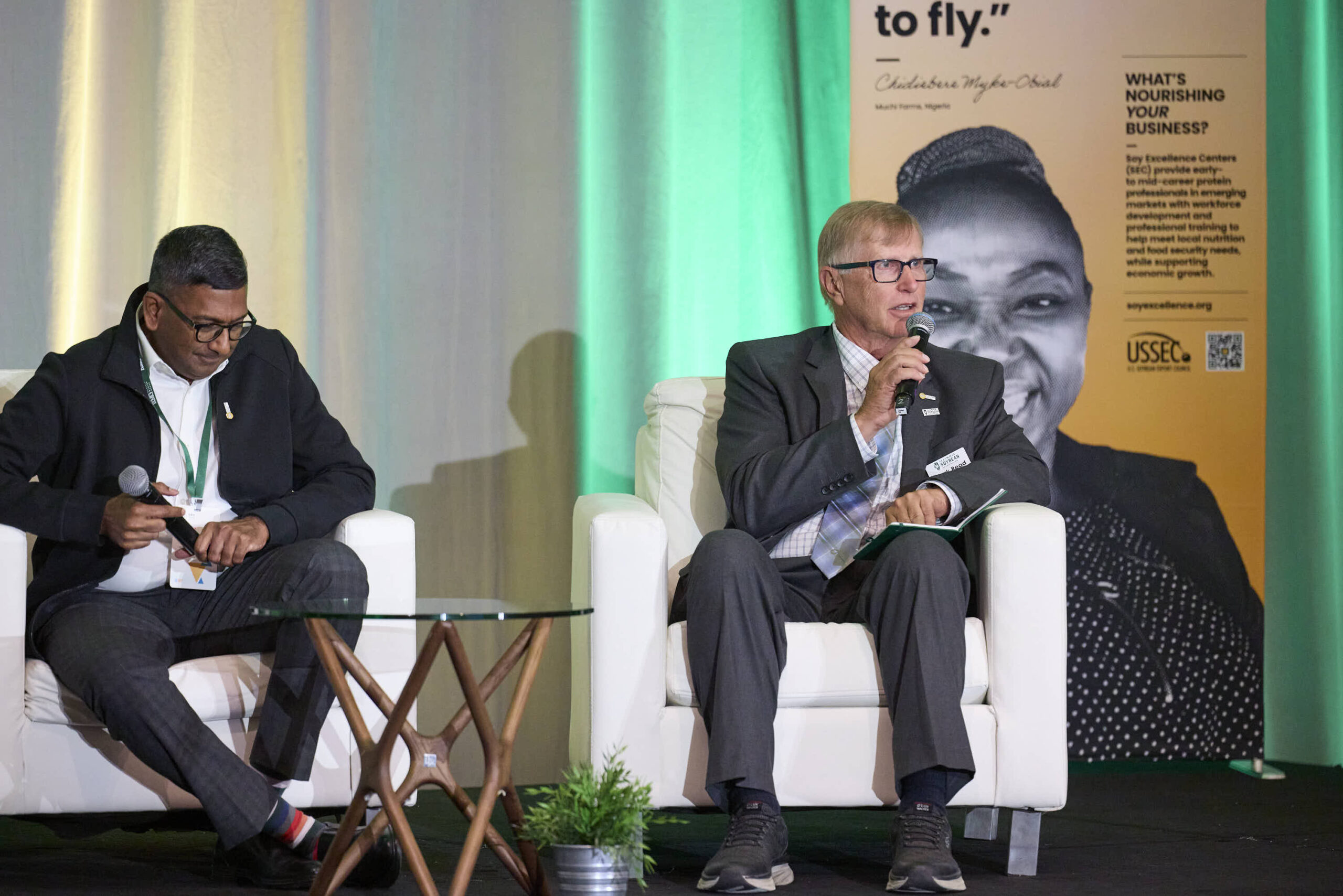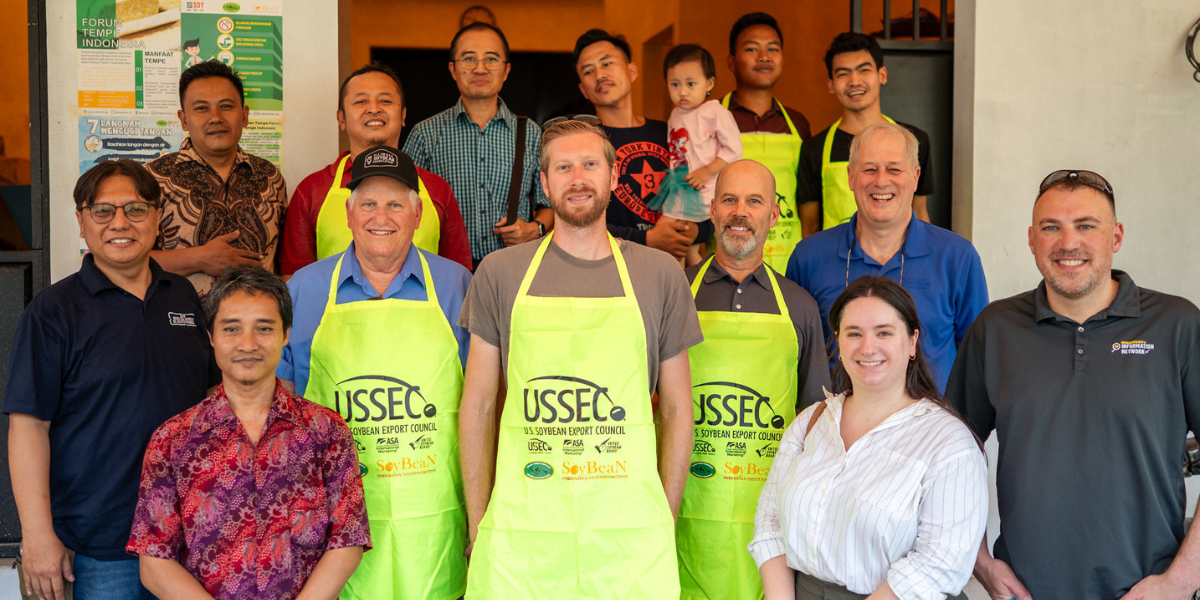By Erin Worrell, Communications Manager, U.S. Soybean Export Council
In Illinois, the 2024 soybean crop was estimated at about 709.5 million bushels, contributing to an expected U.S. soy crop of 4.6 billion bushels, according to the USDA’s August Crop Production Report. The corresponding World Agricultural Supply and Demand Estimates Report from USDA projects soy supply up 11 percent over last year.
Against the backdrop of this strong crop, the U.S. Soybean Export Council (USSEC) hosted Soy Connext 2024, the Global U.S. Soy Summit, from Aug. 19-21 in San Francisco. Illinois Soybean Association (ISA) was among the sponsors.
The summit convened more than 400 international soy customers from 62 countries, including Bangladesh, China, Egypt, Indonesia, Japan, Mexico, and more, to learn and network. Of those customers, 40 percent attended their first Soy Connext. Many of these customers participated in a trade team tour, visiting farms and soy supply chain partners specific to their business before or after Soy Connext.
“Illinois exports 60 percent of our soybeans, so we have to have markets for them to go to,” says Scott Gaffner, who farms near Greenville, Ill., and serves as a Board Director for ISA and the World Initiative of Soy in Human Health (WISHH). “USSEC is so important to the relationships with our export markets. They know the buyers and have credibility for our exports to be successful.”
David Wessel farms near Chandlerville, Ill., and serves as a Board Director for ISA and the United Soybean Board. He agrees with Gaffner and adds, “I live on the Illinois River, so 100 percent of my soybeans go that route. That river access opens a lot of avenues and new markets for farmers in our state, so connecting with customers at events is critical.”
Both Gaffner and Wessel attended Soy Connext 2024. Throughout Soy Connext, USSEC tackled tough questions and shared data to elevate a preference for U.S. soy products among global customers. Speakers and sessions aimed to differentiate the quality and value of U.S. soy from other nutrition and vegetable oil products. Compared to those in recent years, current prices allow international customers to benefit from the many advantages of U.S. soy.
Although soybeans are sold as a commodity oilseed, research continues to show that U.S. soy is a premium product that increases operational efficiencies for livestock farms, feed mills, and oil crushers. It also introduces better flavor profiles in the soy foods sector. And U.S. soy has the lowest carbon footprint compared to soy of other origins thanks to on-farm stewardship and conservation efforts of Illinois soybean farmers and others throughout the U.S.
“In my conversations with buyers from China during breakfast, we did a deep dive into farming and what this year’s crop looks like,” Wessel reports. “They love our quality and say it is easier to work with U.S. soy compared to soybeans of other origins. Exceptional quality is our selling point.”
One Soy Connext session on the value of adding U.S. soy to animal and aqua feeds shared modeling data that quantifies the value of the nutritional package delivered by U.S. soy as a feed ingredient. Based on current prices, the model showed that U.S. soy adds $51 per metric ton in nutrient value to fish feed in Indonesia. In Ecuador, the model showed U.S. soy could add $76 per metric ton in nutrient value to shrimp feed. As it relates to sustainability, the Global Feed LCA Institute’s database indicates that when meal used in feed is made with 100 percent U.S. soybeans, the feed’s carbon footprint can be reduced approximately 20 percent. During the session on animal and aqua feed, data modeling clearly showed lower greenhouse gas emissions from U.S. soy compared to soy of other origins.
USSEC developed one of the first sustainability verification schemes, known as the U.S. Soy Sustainability Assurance Protocol (SSAP), and about 70 percent of U.S. soy exports now carry SSAP certification. As of mid-August, international U.S. soy customers can request that carbon footprint be included on their SSAP certificates. This data, sourced from the Global Feed LCA Institute database, offers a calculation based on the quantity of soy purchased and can be used in their carbon accounting.
Global U.S. soy customers and supply chain leaders appreciate the knowledge shared at Soy Connext, but they value the unparalleled networking even more. They enjoy connecting with farmers, visiting farms, and seeing firsthand the logistics that make U.S. soy incredibly reliable.
“I hosted a trade team from South Asia and Sub-Saharan Africa on my farm, including two important influencers I had met on previous trade missions to India and Vietnam,” Gaffner says. “The team loved hearing about our family farming heritage and the care we take to ensure a high-quality crop. The technology we used to be efficient and sustainable impressed them, and the size of our equipment made a huge impression. They learned how we produce a large crop with few people.”
“The conversations continued here at Soy Connext,” he continues. “Those relationships transcend into developing trust, and they are an integral part of developing export markets. They will open doors for trade in the future.”
Through Soy Connext 2024, USSEC encouraged international customers to look beyond the status quo to the data that better demonstrates the value of U.S. soy to learn how to unlock the profit potential it offers. Illinois farmers can expect that to translate to growing export demand in the 2024/25 marketing year and beyond for U.S. soybeans and soybean meal.
Recent Articles
ISA recently traveled to Indonesia to explore growth potential for U.S. soy's No. 4 trade partner.
By IL Field & Bean Team






